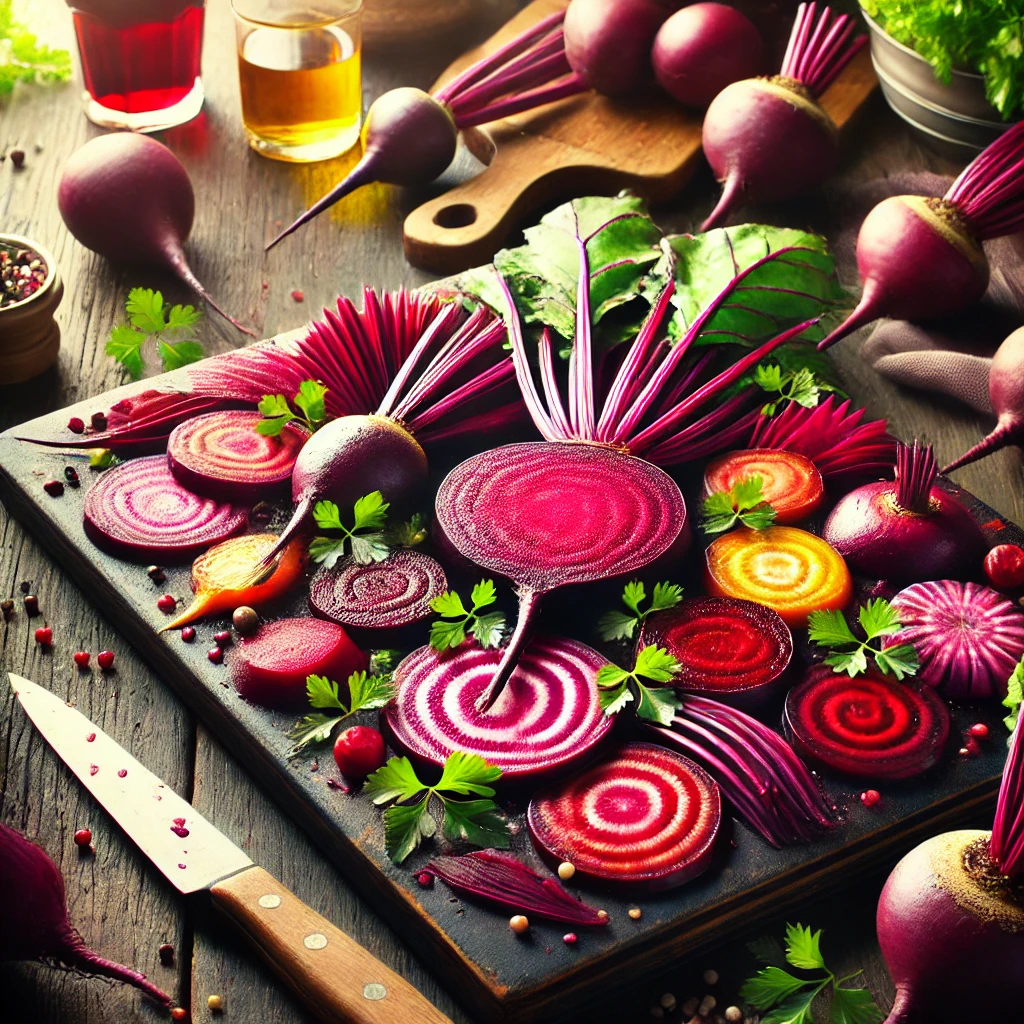
Have you ever struggled with how to cook beets just right?
Whether they turn out too hard or lose their vibrant color, it’s easy to see why beets might feel a bit intimidating in the kitchen.
But don’t worry—perfectly tender, flavorful beets are just a few simple steps away!
In this post, I’ll show you 5 foolproof methods to cook beets that will elevate any dish, from salads to sides and even smoothies.
Plus, you’ll discover how to retain their natural sweetness and nutritional power in every bite.
Beets are not only delicious but also incredibly good for you.
Packed with essential nutrients like fiber, folate, and antioxidants, they support everything from heart health to detoxification.
So, let’s dive into the five best ways to cook beets and unlock their full potential.
1. Boiling: The Easiest Method
Step-by-Step Instructions:
- Wash and Trim: Wash your beets thoroughly under cold water and trim off the greens, leaving about 1-2 inches of the stem.
- Boil the Beets: Place the beets in a large pot and cover them with water. Let the water boil then reduce the heat to simmering. Cook for 30-40 minutes, depending on the size of the beets.
- Test for Doneness: Use a fork or knife to poke the beets. They should slide in easily when fully cooked.
- Peel the Beets: After boiling, let the beets cool slightly, then use your fingers remove skin ( you can also use a paper towel).
- Season and Serve: Slice or cube the beets and season with salt, pepper, and olive oil, or use them in your favorite salads.
Best For:
- Salads, side dishes, and pickling.
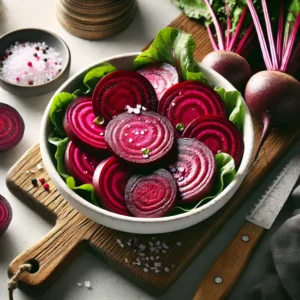
Boiled Beets Recipe
Ingredients
- 4 medium beets
- Water for boiling
- Salt optional
- Olive oil optional for seasoning
Instructions
- Wash and Trim: Rinse beets under cold water, cutting off the greens but leaving 1-2 inches of stems attached.
- Boil: Place beets in a large pot, cover with water, and bring to a boil. Reduce heat to a simmer and cook for 30-40 minutes, depending on the size of the beets.
- Check for Tenderness: Insert a fork into the beets to check doneness—they should be tender but not mushy.
- Peel: Once cooled slightly, use a paper towel or your hands to rub off the beet skins.
- Serve: Slice and season with salt and a drizzle of olive oil if desired.
NUTRITIONAL INFORMATION (per serving):
- Carbohydrates: 13g
- Fiber: 3g
- Sugar: 9g
- Protein: 2g
- Fat: 0g
- Vitamin C: 6% of Daily Value
- Iron: 4% of Daily Value
Notes
Tips:
- To preserve beet color, add a splash of vinegar to the boiling water.
- You can boil the beet greens too! They’re packed with nutrients.
2. Roasting: Enhance the Natural Sweetness
Step-by-Step Instructions:
- Preheat Oven: Preheat your oven to 400°F (200°C).
- Prepare the Beets: Wash the beets and trim the stems, leaving about 1 inch. Wrap each beet individually in aluminum foil and place them on a baking sheet.
- Roast the Beets: Roast for 45-60 minutes, depending on their size. You’ll know they’re done when you can easily pierce them with a fork.
- Peel and Serve: Once cool, unwrap the beets and peel the skin off. Slice, dice, or serve whole as desired.
Flavor Tips:
- Drizzle roasted beets with olive oil and sprinkle with sea salt, fresh herbs, or a splash of balsamic vinegar for an extra layer of flavor.
Best For:
- Salads, roasted vegetable medleys, grain bowls.
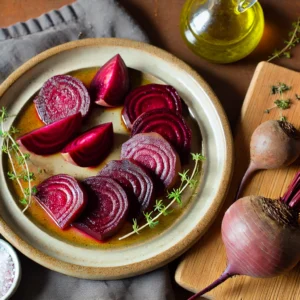
Roasted Beets Recipe Card
Ingredients
- 4 medium beets
- 2 tablespoons olive oil
- Salt and pepper to taste
Instructions
- Preheat Oven: Preheat your oven to 400°F (200°C).
- Wrap Beets: Rinse beets and wrap each individually in aluminum foil.
- Roast: Place wrapped beets on a baking sheet and roast for 45-60 minutes, depending on size. use a fork to check doneness.
- Peel and Slice: Let cool, unwrap, and peel the skin off. Slice or dice as desired.
- Serve: Drizzle with olive oil and season with salt and pepper.
NUTRITIONALINFORMATION (per serving):
- Carbohydrates: 19g
- Fiber: 4g
- Sugar: 13g
- Protein: 3g
- Fat: 1g
- Vitamin A: 2% of Daily Value
- Vitamin C: 8% of Daily Value
Notes
Tips:
- For added flavor, toss beets with rosemary or thyme before roasting.
- Roasted beets pair well with goat cheese or balsamic vinegar.
3. Steaming: The Nutrient-Saving Method
Step-by-Step Instructions:
- Set Up the Steamer: Fill a pot with 1-2 inches of water and place a steamer basket inside.
- Steam the Beets: Place trimmed beets in the steamer basket and cover with a lid. Steam for 30-40 minutes or until tender.
- Cool and Peel: After steaming, allow the beets to cool slightly before peeling the skin off.
Best For:
- Retaining nutrients and adding to soups, salads, or side dishes.
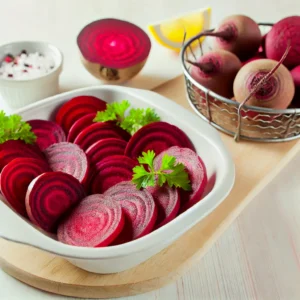
Steamed Beets Recipe
Ingredients
- 4 medium beets
- Water for steaming
Instructions
- Prepare Steamer: Fill a pot with 1-2 inches of water and place a steamer basket over it.
- Steam Beets: Place trimmed beets in the steamer basket and cover with a lid. Steam for 30-40 minutes until tender.
- Cool and Peel: Allow the beets to cool slightly before peeling the skin off.
- Serve: Slice and serve warm or cold.
NUTRITIONAL INFORMATION (per serving):
- Carbohydrates: 13g
- Fiber: 3g
- Sugar: 9g
- Protein: 2g
- Fat: 0g
- Vitamin C: 6% of Daily Value
- Iron: 4% of Daily Value
Notes
Tips:
- Steaming preserves the most nutrients. For added flavor, drizzle with olive oil and lemon juice.
- Steamed beets can be stored in the fridge for up to 5 days.
4. Microwaving: Quick and Convenient
Step-by-Step Instructions:
- Prepare the Beets: Wash and trim the beets. Pierce each beet a few times with a fork.
- Microwave: Place the beets in a microwave-safe dish, add a splash of water, and cover loosely with a lid or microwave-safe wrap. Cook on high for 8-12 minutes, depending on their size, turning halfway through.
- Peel and Enjoy: Let the beets cool for a minute or two before peeling off the skin.
Best For:
- A quick addition to salads, smoothies, or bowls when you’re short on time.
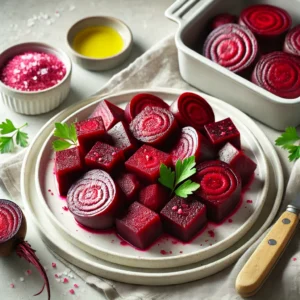
Microwaved Beets Recipe
Ingredients
- 4 medium beets
- 1/4 cup water
Instructions
- Instructions:
- Prepare Beets: Wash and trim the beets, then pierce each a few times with a fork.
- Microwave: Place beets in a microwave-safe dish with 1/4 cup water.
- Cook: Microwave on high for 8-12 minutes, turning halfway through. Beets should be tender.
- Peel and Serve: Allow the beets to cool slightly before peeling. Slice and enjoy.
NUTRITIONAL INFORMATION (per serving):
- Carbohydrates: 13g
- Fiber: 3g
- Sugar: 9g
- Protein: 2g
- Fat: 0g
- Vitamin C: 6% of Daily Value
- Iron: 4% of Daily Value
Notes
Tips:
- Adjust cooking time based on the size of the beets. Larger beets may need more time.
- This method is ideal when you’re in a rush but still want a healthy, home-cooked side.
5. Grilling: For a Smoky, Charred Flavor
Step-by-Step Instructions:
- Preheat the Grill: Heat your grill to medium-high.
- Prep the Beets: Peel the beets and cut them into thick slices. Coat with olive oil and sprinkle with salt and pepper.
- Grill the Beets: Place the slices directly on the grill and cook for 4-5 minutes on each side until they have nice grill marks and are tender.
- Serve: Use grilled beets as a side, or add them to salads or sandwiches.
Best For:
- BBQs, adding a smoky flavor to salads and sides.

Grilled Beets Recipe
Ingredients
- 4 medium beets
- 2 tablespoons olive oil
- Salt and pepper to taste
Instructions
- Preheat Grill: Heat your grill to medium-high.
- Prep Beets: Peel the beets and cut them into thick slices. Brush with olive oil and season with salt and pepper.
- Grill: Place beet slices directly on the grill and cook for 4-5 minutes per side until tender and charred.
- Serve: Remove from grill and serve as a side or in salads.
NUTRITIONAL INFORMATION (per serving):
- Carbohydrates: 19g
- Fiber: 4g
- Sugar: 13g
- Protein: 3g
- Fat: 3g
- Vitamin C: 10% of Daily Value
- Iron: 6% of Daily Value
Notes
Tips:
- For added flavor, toss grilled beets with fresh herbs or a citrus vinaigrette.
- Grilled beets pair well with grilled meats, or can be served as a vegetarian main.
Pro Tips for Cooking Perfect Beets
- Preserve Color: To prevent beets from losing their vibrant color, add a splash of vinegar or lemon juice to the cooking water.
- Avoid Mess: Beet juice can stain! Use gloves when peeling or cutting beets, and line your cutting board with parchment paper.
- Choosing Beets: Look for firm, smooth beets with bright green leaves attached (if possible). Smaller beets tend to be more tender and sweeter than large ones.
- Flavor Boosters: Add herbs like rosemary or thyme, or drizzle your beets with balsamic glaze or citrus vinaigrette for an extra pop of flavor.
Nutritional Benefits of Beets
Beets are often hailed as a superfood, and for good reason!
These vibrant root vegetables are packed with essential vitamins, minerals, and antioxidants, making them a nutritious addition to any diet.
Whether you enjoy them raw, boiled, roasted, or pickled, here are the key nutritional benefits that make beets such a powerhouse:
1. Rich in Essential Nutrients
Beets are a great source of several essential vitamins and minerals:
- Folate (Vitamin B9): Beets are especially rich in folate, a B-vitamin crucial for cell function, DNA production, and preventing birth defects. Just one cup of cooked beets provides about 37% of the recommended daily intake of folate.
- Manganese: This mineral plays an important role in bone formation, nutrient absorption, and the regulation of blood sugar and insulin. Beets offer about 14% of your daily manganese needs in one serving.
- Potassium: Beets are high in potassium, a mineral that helps regulate blood pressure, fluid balance, and muscle contractions. Eating beets can help support heart health and muscle function.
2. High in Antioxidants
Beets contain powerful antioxidants, which are compounds that help fight oxidative stress in the body.
The primary antioxidants in beets are betalains, which give them their deep red or purple color:
- Betalains: These pigments have anti-inflammatory and antioxidant properties. Studies suggest they may help protect cells from damage, reduce inflammation, and even have potential cancer-fighting properties.
- Vitamin C: While not as high as citrus fruits, beets still provide a good dose of Vitamin C, which supports immune function, skin health, and wound healing.
3. Heart Health
Beets are known to promote heart health in multiple ways:
- Lower Blood Pressure: The nitrates found in beets are converted to nitric oxide in the body, which helps relax and dilate blood vessels, improving circulation and reducing blood pressure. Studies have shown that drinking beet juice or eating beets can lower systolic blood pressure by up to 4-10 mmHg within a few hours.
- Improve Blood Flow: By increasing nitric oxide levels, beets enhance blood flow and oxygen delivery throughout the body, which is particularly beneficial for athletes or people with cardiovascular conditions.
- Reduce Cholesterol: Some studies have shown that beetroot consumption can help reduce levels of “bad” LDL cholesterol while promoting “good” HDL cholesterol, supporting overall heart health.
4. Boost Exercise Performance
One of the most popular benefits of beets is their ability to enhance physical performance and endurance:
- Increased Stamina: The nitrates in beets help improve oxygen use and increase stamina during exercise. Studies suggest that athletes who consume beet juice before a workout can increase endurance by up to 16%, allowing them to exercise longer with less fatigue.
- Faster Recovery: The anti-inflammatory properties of beets, along with their nitrates, can help with sore muscles.
5. Support Detoxification
Beets are a natural detoxifier for the liver:
- Betalains: These pigments, specifically found in beets, support phase 2 detoxification in the liver, helping it process and eliminate toxins more efficiently. This is why beets are often included in detox and cleansing diets.
- Fiber: Beets are also high in fiber, which promotes healthy digestion and regular bowel movements. Fiber helps your body eliminate waste and toxins more effectively.
6. Anti-Inflammatory Properties
Chronic inflammation is linked to many diseases, including heart disease, cancer, and autoimmune disorders.
The betalains found in beets have been shown to reduce markers of inflammation in the body, potentially lowering the risk of these diseases.
Including beets in your diet may help mitigate inflammation and support overall health.
7. Digestive Health
Beets are rich in fiber, which plays a crucial role in maintaining healthy digestion.
One cup of cooked beets contains about 4 grams of fiber, which is roughly 15% of the recommended daily intake.
The benefits of fiber in beets include:
- Improved Gut Health: Fiber promotes the growth of beneficial gut bacteria, which are important for overall digestive health and immune function.
- Preventing Constipation: Eating fiber-rich foods like beets can help keep your digestive system regular and prevent constipation.
- Weight Management: Fiber helps you feel full for longer, which can aid in weight management by reducing overeating.
8. Brain Health
Nitric oxide, produced from the nitrates in beets, not only improves blood flow to the muscles and heart but also enhances circulation to the brain.
This increased blood flow to the brain is especially beneficial for cognitive function:
- Improved Mental Function: Studies suggest that the increased nitric oxide from beet consumption may help improve cognitive function, particularly in older adults.
- It has been linked to improved memory and reduced risk of cognitive decline.
- Potential Protection Against Dementia: Some research has shown that beet consumption may help slow the progression of neurodegenerative diseases like dementia by improving brain oxygenation.
9. Blood Sugar Regulation
Despite their natural sweetness, beets have a low glycemic index (GI) of around 61, meaning they do not cause rapid spikes in blood sugar levels.
The fiber content in beets helps slow down the absorption of sugar in the bloodstream, making them a suitable food for people managing blood sugar levels:
- Stabilize Blood Sugar: The fiber in beets helps regulate blood sugar and prevent spikes, which is beneficial for people with diabetes or those at risk of developing the condition.
- Low Calorie and Nutrient-Dense: Beets are relatively low in calories, with just 58 calories per cup of cooked beets, but they pack a nutritional punch, making them a great addition to a balanced diet.
10. Beets for Skin Health
Beets’ rich antioxidant content, particularly Vitamin C and betalains, can help promote healthy, glowing skin:
- Combat Aging: The antioxidants in beets help neutralize free radicals, which can cause premature aging. Regular consumption of beets can support collagen production and improve skin elasticity.
- Natural Detoxification: By promoting liver health and detoxification, beets indirectly help cleanse the body, which can lead to clearer, more radiant skin.
In summary, beets are a nutritional powerhouse that offer numerous health benefits, from supporting heart health and boosting athletic performance to promoting digestive health and reducing inflammation.
Whether eaten raw, roasted, boiled, or in juice form, adding beets to your diet is a simple way to enhance your overall health and wellbeing.
Creative Recipes to Use Cooked Beets
Once you’ve mastered the art of cooking beets using the methods we’ve covered, the fun part is incorporating them into a variety of dishes.
Cooked beets are versatile and can add a vibrant color, earthy flavor, and loads of nutrition to your meals. Here are some creative ways to enjoy your perfectly cooked beets:
1. Beet Hummus
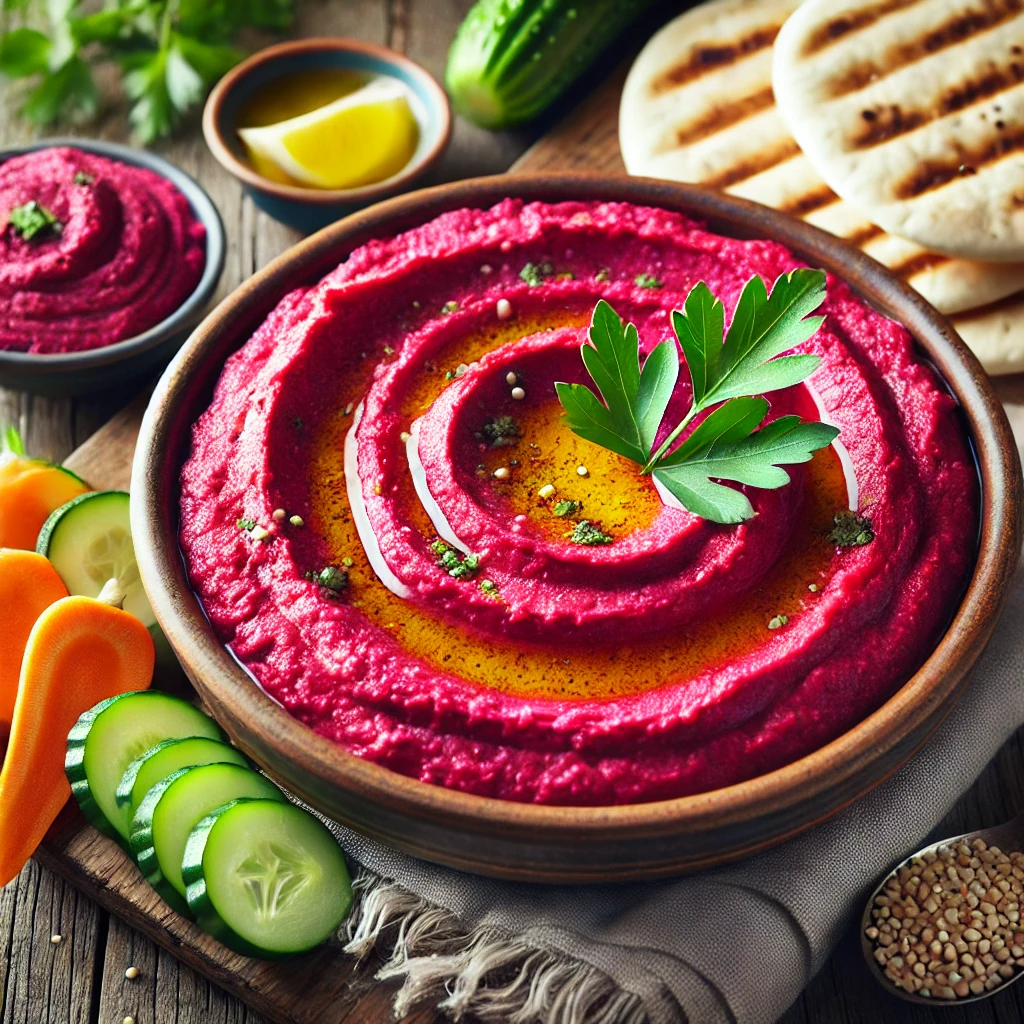
- Description: Give your traditional hummus a colorful and nutrient-packed twist by adding roasted or steamed beets to the mix. The beets add a subtle sweetness and a vibrant pink color that’s sure to impress at parties or gatherings.
- How to Make: Blend roasted beets with chickpeas, tahini, garlic, lemon juice, and olive oil in a food processor. Season with salt and pepper to taste.
- Serving Suggestions: Serve with pita bread, fresh vegetables, or spread it on sandwiches for a nutritious snack or appetizer.
2. Roasted Beet and Goat Cheese Salad

- Description: This classic combination of sweet roasted beets and tangy goat cheese makes for a beautifully balanced and flavorful salad. The creamy cheese complements the earthy beets, while adding texture and richness.
- How to Make: Toss roasted beets with arugula or mixed greens, crumbled goat cheese, walnuts, and a simple vinaigrette made from olive oil, balsamic vinegar, and honey.
- Serving Suggestions: Serve as a starter or side dish for dinner, or add grilled chicken or salmon for a complete meal.
3. Beet Smoothie
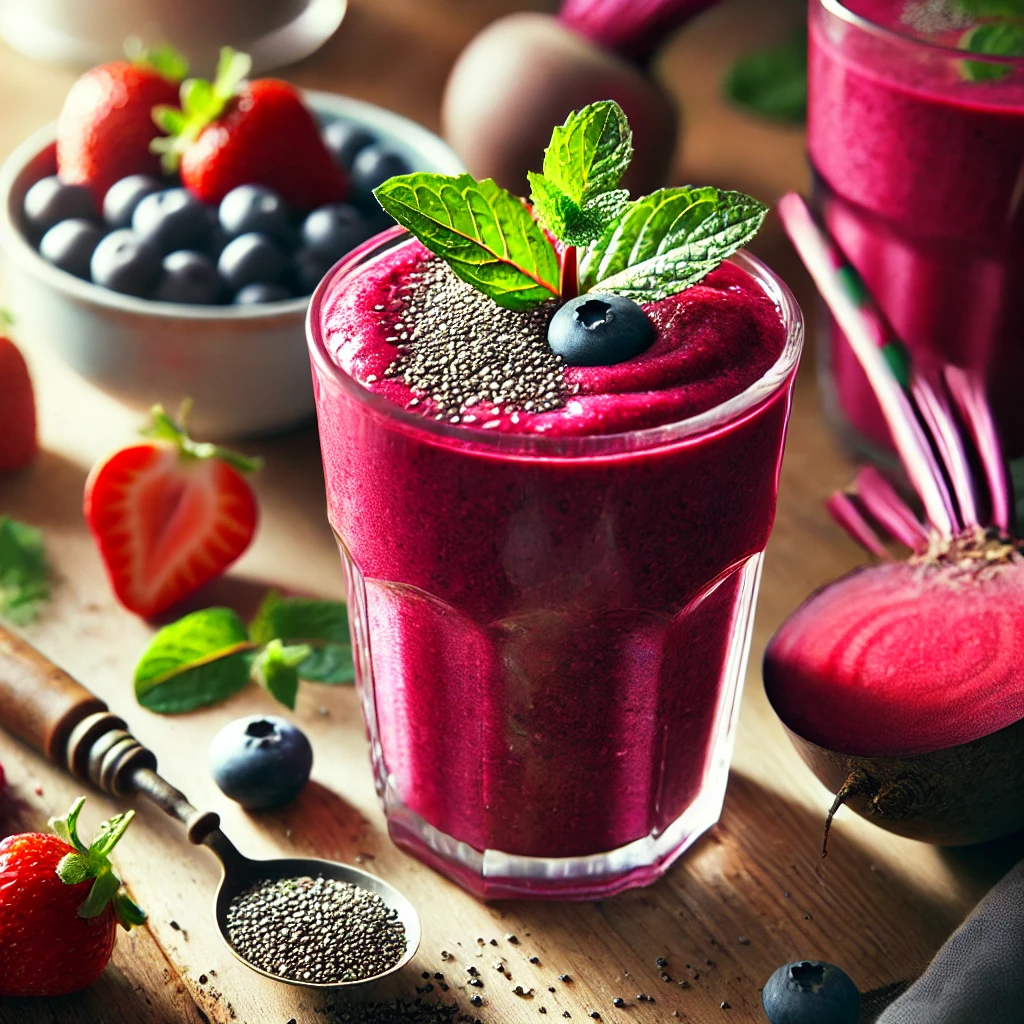
- Description: Boost your morning routine with a vibrant, nutrient-dense beet smoothie. Adding cooked beets to your smoothie not only enhances its nutritional profile but also provides a beautiful magenta color.
- How to Make: Blend boiled or steamed beets with frozen berries, banana, Greek yogurt, almond milk, and a drizzle of honey. You can also add a handful of spinach or kale for an extra boost of greens.
- Serving Suggestions: Enjoy as a breakfast option, post-workout snack, or a midday energy boost.
4. Beet and Sweet Potato Hash
- Description: This hearty and colorful hash is perfect for breakfast or brunch. The combination of roasted beets and sweet potatoes adds sweetness and depth, while sautéed onions and garlic provide savory notes.
- How to Make: Roast diced beets and sweet potatoes until tender. In a skillet, sauté onions and garlic in olive oil, then add the roasted veggies and cook until crispy. Top with fried or poached eggs for a complete meal.
- Serving Suggestions: Serve with avocado slices and a sprinkle of fresh herbs like parsley or chives.
5. Beet Chips
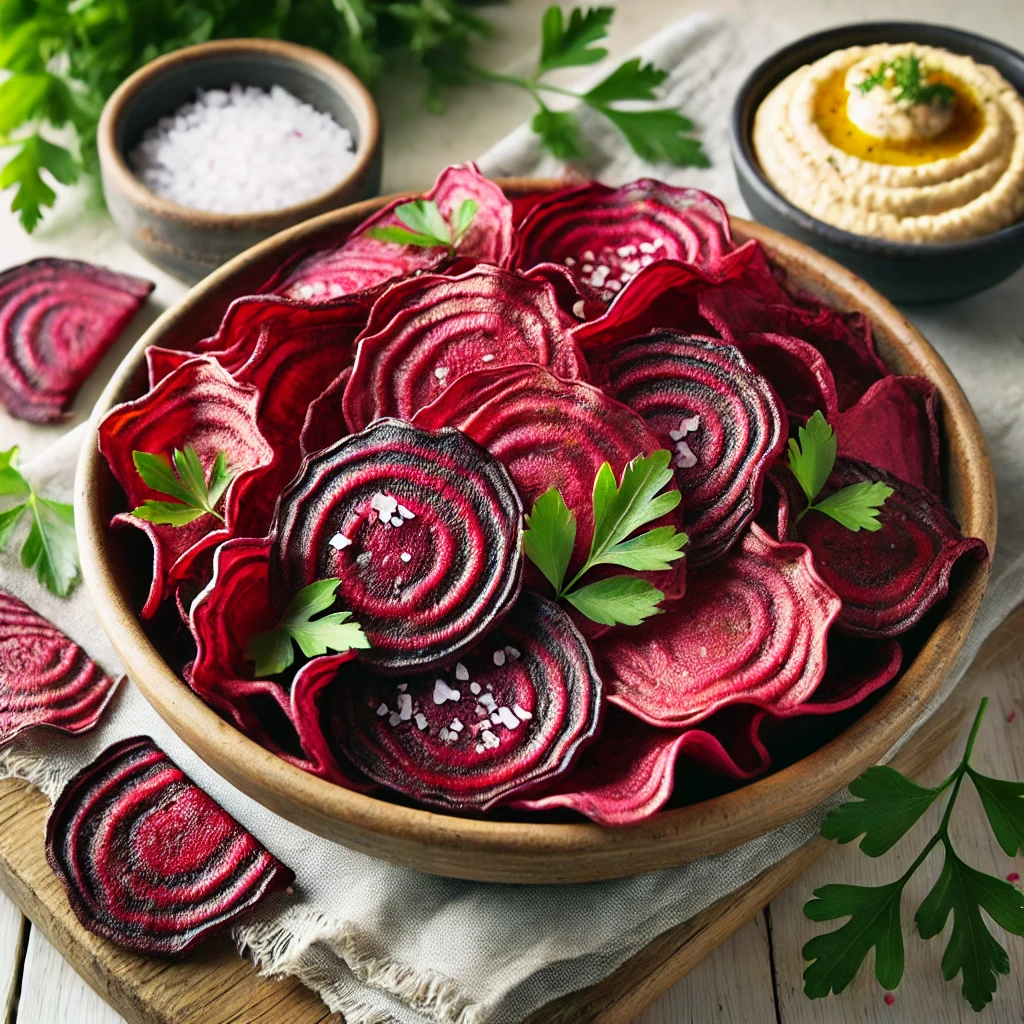
- Description: Swap your regular potato chips for these crispy, oven-baked beet chips. They’re a healthier alternative and still deliver the satisfying crunch you crave in a snack.
- How to Make: Thinly slice cooked beets (preferably roasted for added flavor) using a mandolin or sharp knife. Toss the slices in olive oil, sprinkle with sea salt, and bake at 350°F (175°C) for 15-20 minutes, flipping halfway through.
- Serving Suggestions: Enjoy on their own as a snack, or pair them with your favorite dip, such as beet hummus or guacamole.
6. Beet Pasta Sauce
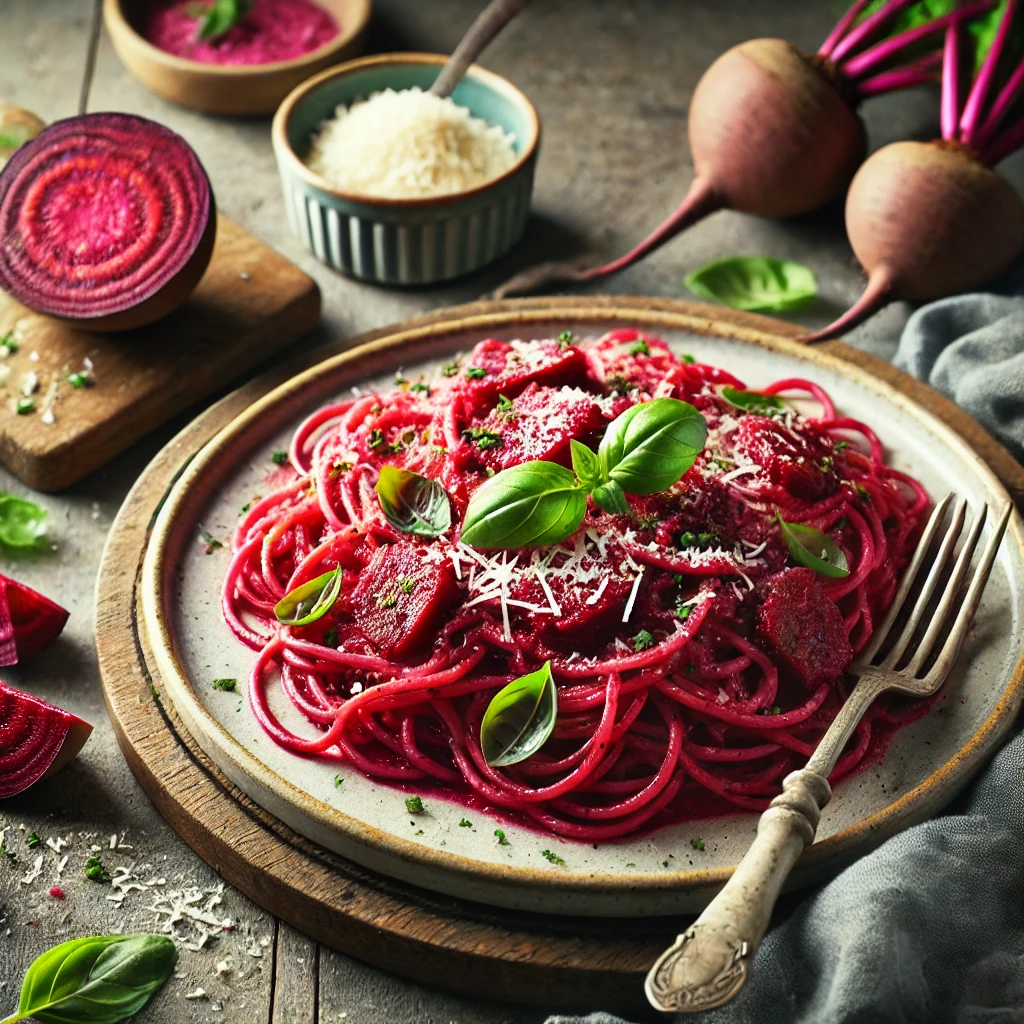
- Description: Transform your pasta dishes with a rich and velvety beet sauce. This unexpected twist gives the sauce a beautiful color and an earthy-sweet flavor that pairs well with creamy ingredients.
- How to Make: Puree roasted or steamed beets with olive oil, garlic, and a splash of cream or ricotta cheese. Add this beet sauce to cooked pasta, such as penne or fettuccine, and top with Parmesan cheese and fresh herbs.
- Serving Suggestions: Serve with a side of garlic bread or a green salad for a complete meal.
7. Beet Risotto
- Description: Elevate your traditional risotto by adding roasted or steamed beets. The result is a creamy, colorful dish that’s both visually stunning and deliciously earthy.
- How to Make: Prepare risotto by sautéing onions and garlic in butter, then adding Arborio rice. Gradually add vegetable stock until the rice is tender. Stir in pureed roasted beets and a touch of mascarpone cheese for creaminess.
- Serving Suggestions: Garnish with fresh thyme and a sprinkle of Parmesan cheese. This dish pairs well with a crisp white wine or a side of roasted vegetables.
8. Beet Carpaccio
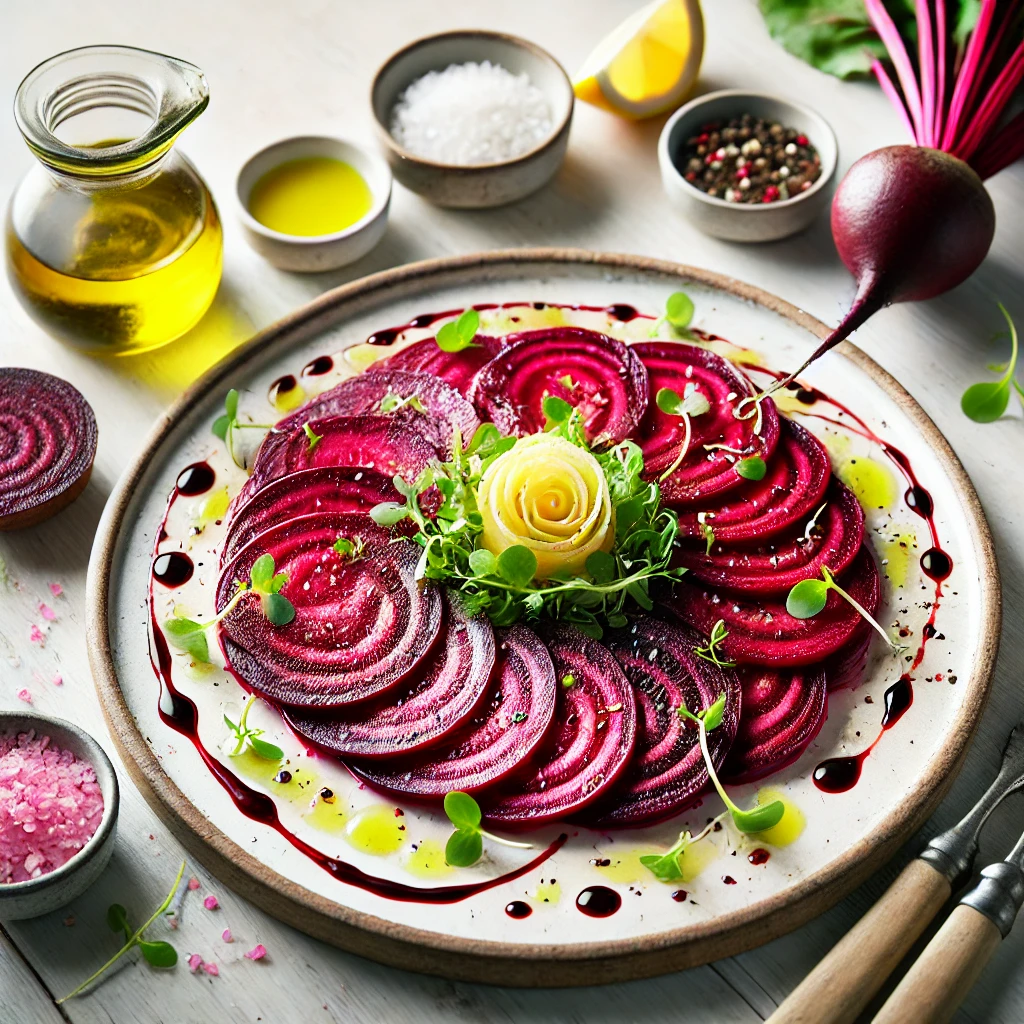
- Description: This light and refreshing dish is a plant-based take on the classic Italian carpaccio. Thinly sliced beets are dressed with a zesty vinaigrette, creating a beautiful appetizer or salad that’s both elegant and healthy.
- How to Make: Slice roasted or boiled beets as thin as possible and arrange them on a plate. Drizzle with olive oil, lemon juice, and balsamic vinegar, then sprinkle with sea salt, black pepper, and fresh herbs.
- Serving Suggestions: Serve with crusty bread or crostini. For added flavor, top with crumbled feta or goat cheese.
9. Beet Soup (Borscht)
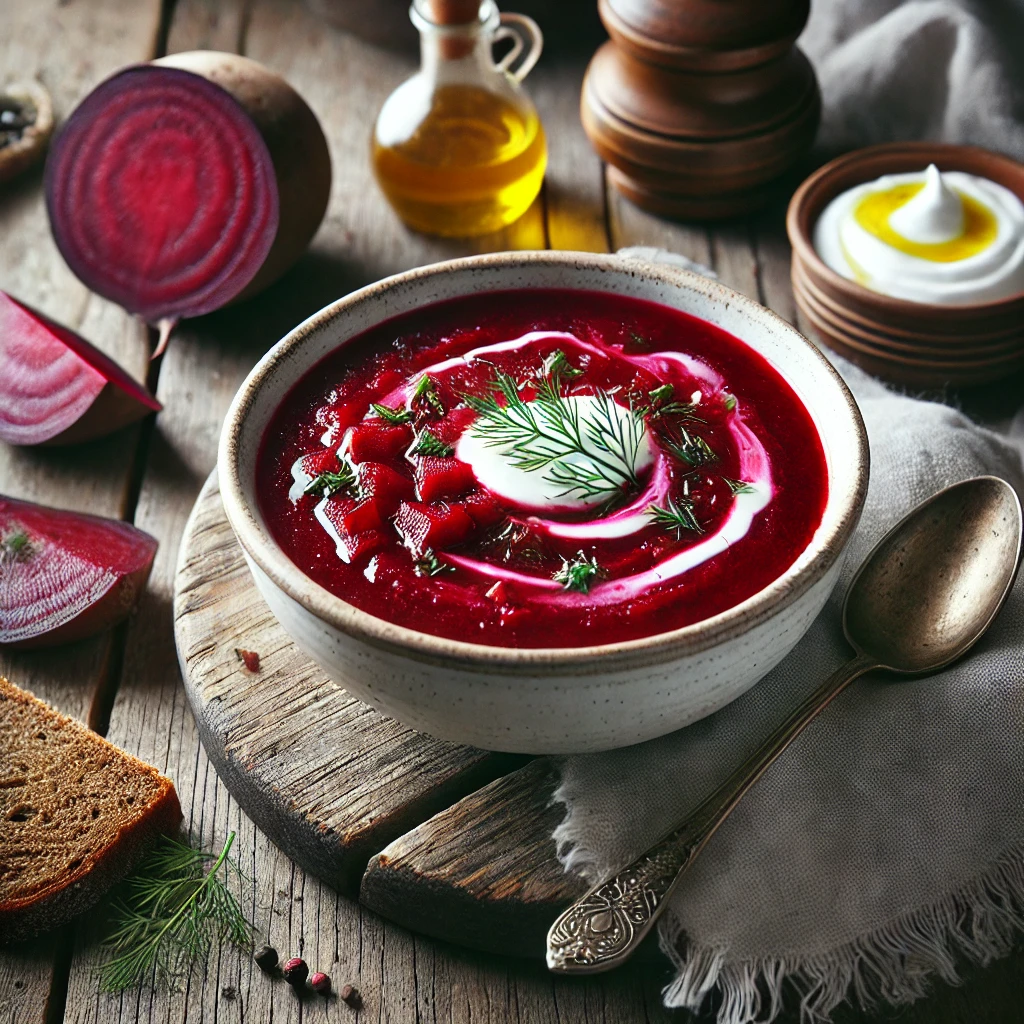
- Description: This traditional Eastern European soup is made with beets and is both hearty and flavorful. Borscht can be served hot or cold and is known for its bright red color and comforting flavors.
- How to Make: Simmer cooked beets with onions, carrots, cabbage, and potatoes in vegetable broth. Add a splash of vinegar or lemon juice for acidity and season with dill. Serve with a dollop of sour cream.
- Serving Suggestions: Enjoy as a starter or a light meal with rye bread on the side.
10. Pickled Beets
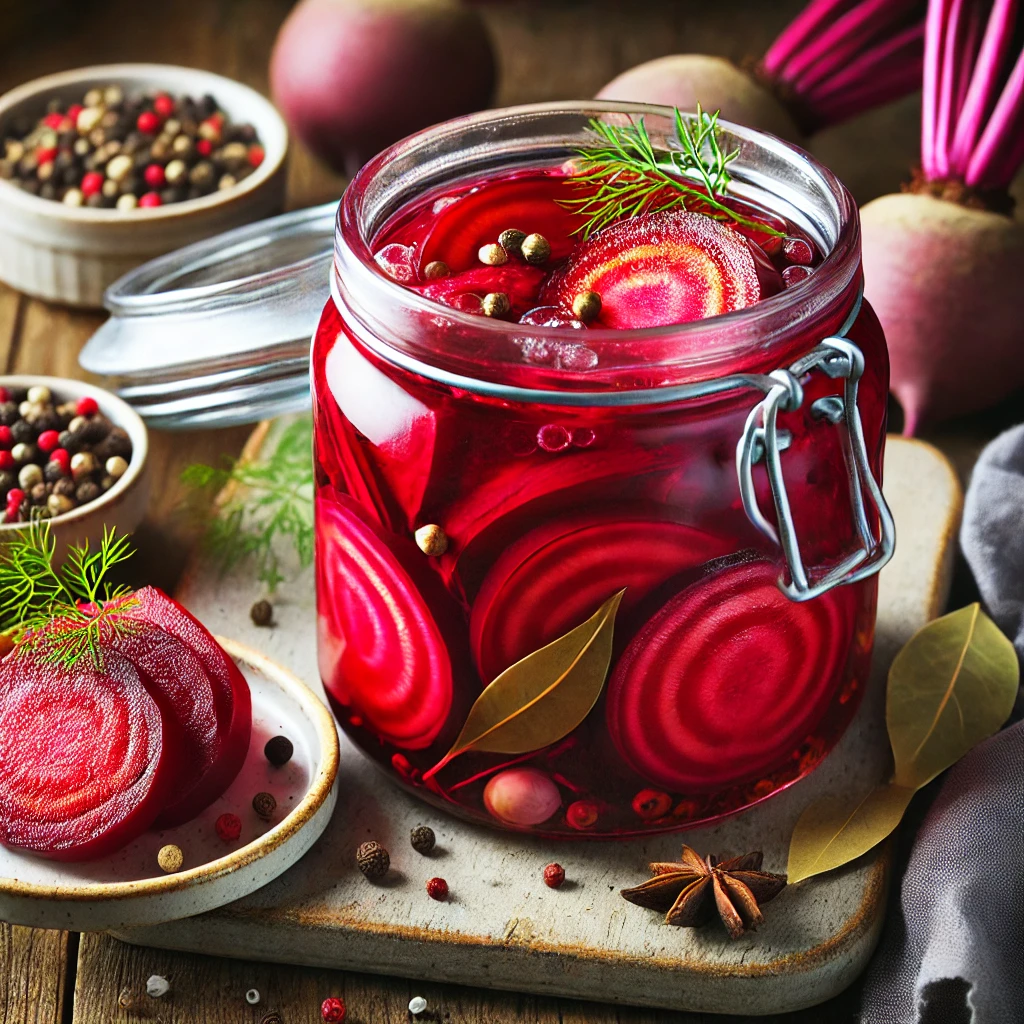
- Description: Pickling beets is a great way to preserve them for later use. The tangy, sweet flavor of pickled beets makes them a perfect addition to salads, sandwiches, or charcuterie boards.
- How to Make: Simmer sliced boiled or roasted beets in a mixture of vinegar, water, a sweetener of your choice and some spices (peppercorns and cloves are a good choice). Let cool, then transfer to a jar and refrigerate for at least 24 hours before serving.
- Serving Suggestions: Serve pickled beets with goat cheese, in sandwiches, or as part of a salad.
By incorporating these creative recipes, you can transform simple cooked beets into exciting dishes that are both delicious and packed with nutrition. Whether you’re looking for a healthy snack, a colorful salad, or a hearty main dish, cooked beets can be the star ingredient in a wide range of meals.
Conclusion
Cooking beets may seem tricky at first, but with these 5 simple methods, you can enjoy perfectly tender and delicious beets every time.
Whether you’re boiling, roasting, steaming, microwaving, or grilling, you now have everything you need to confidently cook beets for any recipe.
So, grab some fresh beets and get cooking—you’ll love the results!
Try one of these methods and let me know how it went in the comments below.
Plus, don’t forget to check out my other vegetable cooking guides to make your kitchen prep even easier!
Related Articles:
How to Cut a Pineapple Like a Pro: Simple Steps for Perfect Slices Every Time



